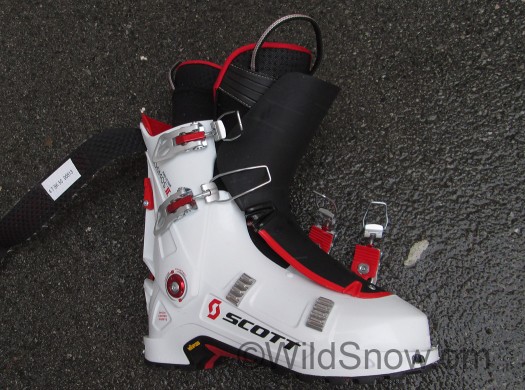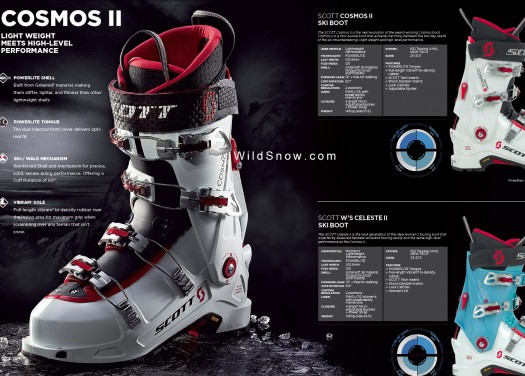If you liked the Garmont boot fit of yesteryear, Scott continues to produce and improve their Cosmos model boot based on Garmont molds. We’ve done quite a few posts about Cosmos, including an epic with (subsequently fixed) problems with the Scott specified tech fittings — which are now in our opinion among the best in the industry in terms of working smoothly with tech bindings. While visiting with Scott at St. Anton I was concentrating on their Alpride airbag pack and a super ski pole “SRS” grip (sounds trival, but it’s not), but I did get reminded that the Cosmos II has some improvements.

The thinking part: One of the problems with 'cabrio' tongue ski boot shells is if you want touring comfort the tongue needs to bend, but it also can provide lots of beef if it's stiff. Cosmos II adds some hinge to the tongue, idea being that when you buckle down the hinge is somewhat canceled out since it's on the sides instead of the former bellows configuration (2013/14 model with black tongue). This is not the first time a hinged tongue has been attempted on a cabrio boot--nicely done in this iteration. That said, the best way to do this is provide some sort of specific latch or lock on the tongue hinge, to cancel it out while your skiing downhill. Tough to do, perhaps Cosmos III? Indeed, in my opinion one of the holy grails of ski boot design is to make a lightweight cabrio boot with a hinged tongue that 100 percent locks stiff for the downhill. Watch for this!
Beyond the dual injection (two kinds of plastic) tongue, biggest changes from original Cosmos are of course the excellent tech fittings, but also the improved (beefed) lean lock (both of these improvements are present in this season’s Cosmos, identified by the black coated tech fittings in the boot toe).
They say the buckles will be strengthened on Cosmos II (some of the original model’s plastic buckle straps broke) as well as being spring loaded in a way that doesn’t hold them open so wide.

Cosmos II, full view. Beyond changes noted above, the new boot might have buckles that are not quite so spring loaded. So they'll spring out of the way, but not so much that you trip on them while walking.

Catalog shot, it looked so tasty I had to publish it. Indeed I should admit that the best stock fit I've ever had with AT boots has been with Garmont, so Cosmos may always be kicking around here. Claimed weight 1450 grams for a size 27.5. Click to enlarge.
Note that Scott is also making a 3-buckle version of this type of boot, with Grilamid shoe and Pebax cuff, men’s is Orbit II (1,300 grams 27.5 catalog weight), women’s is Nova II (1,250 grams 24.5).
There is some history behind all this. Below is Scott’s take from the catalog, with a small bit of editing:
SCOTT & SKI BOOTS – THE RETURN: Ski boot development is not a new realm for Scott Sports. In fact, the company introduced the world’s lightest boot in 1971,known simply as the Scott Ski Boot (Wildsnow editor’s note, one of the strangest but most innovative ski boots ever, was pressed into service by many ski alpinists as a lightweight alternative, see photo below). During this era the Scott boots were considered state-of-the-art products in the freestyle scene and were used by many of the top-level competitors.
(WildSnow note: Along with the Scott boots being used for freestyle, the incredibly lightweight ski boot was the shoe of choice for pioneer extreme skier Patrick Vallencant, who set the tone for ski alpinism in the 1980s.)
Many years later, SCOTT made the decision to stop further production of the ski boot line and focus primarily on the development of poles and goggles.
However, the desire to eventually bring back boots remained in the minds of upper management, with the goal of eventually being able to offer a complete head-to-toe program. In the summer of 2012 this goal became a reality with the acquisition of the ski boot portion of Garmont, located in Montebelluna, Italy, well known as the heart of the ski boot industry. The popular footwear and boot manufacturer held a great reputation, especially in the ski-touring and telemark segment, maintained a wide variety of knowledge, and a lot of experience over the past 20 years. (WildSnow editor’s note, this is an understatement!)
Within just a short period, Senior Product Manager Hervé Maneint reorganized the team, restructured the line and established Scott’s new Research and Development Center near the different suppliers in Montebelluna. Only a few months later SCOTT presented its first complete boot collection at the 2013 ISPO tradeshow and began delivering products to the shops that autumn. Scott is very proud to be able to present new innovations, technologies and designs, as seen in the following highlight products: G1 130 Powerfit WTR, Cosmos II and Orbit II, in the second year of development.
You can use Google images to find many photos of the original Scott boots,late 1970s. One buckle, totally rigid shell other than a softer plastic spoiler. I skied a pair of mountaineering during most of one season, but couldn't get them to fit the way I wanted. They were as light as anything produced today.” title=”Original Scott ski boots, late 1970s. One buckle, totally rigid shell other than a softer plastic spoiler. I skied a pair of mountaineeing during most of one season, but couldn't get them to fit the way I wanted. They were as light as anything produced today.
Our previous Garmont Cosmos ski boot posts are extensive.
Shop for Scott boots formerly Garmont
WildSnow.com publisher emeritus and founder Lou (Louis Dawson) has a 50+ years career in climbing, backcountry skiing and ski mountaineering. He was the first person in history to ski down all 54 Colorado 14,000-foot peaks, has authored numerous books about about backcountry skiing, and has skied from the summit of Denali in Alaska, North America’s highest mountain.

